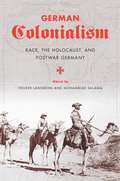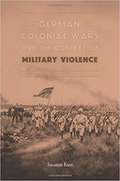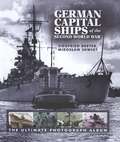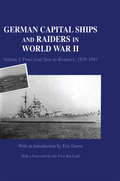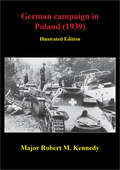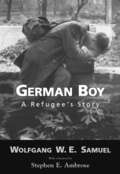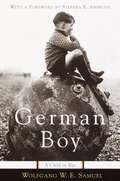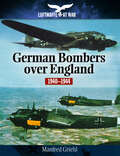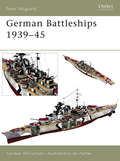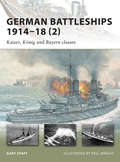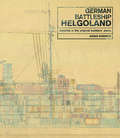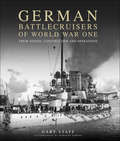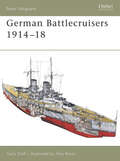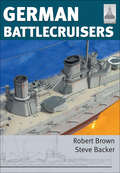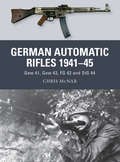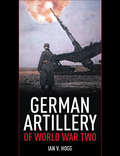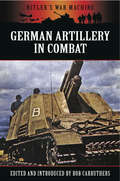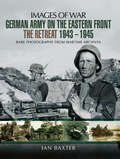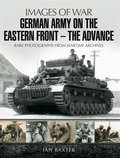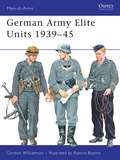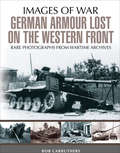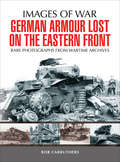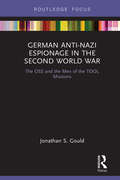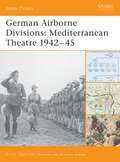- Table View
- List View
German Colonialism: Race, the Holocaust, and Postwar Germany
by Mohammad Salama Volker LangbehnMore than half a century before the mass executions of the Holocaust, Germany devastated the peoples of southwestern Africa. While colonialism might seem marginal to German history, controversial new scholarship compares the acts of this period with Nazi practices on the Eastern and Western fronts. Examples of the most important research conducted on the "continuity thesis" over the past five years, the chapters in this anthology debate the connections between German colonialist activities and the behavior of Germany during World War II. Some argue that the country's domination of southwestern Africa gave rise to perceptions of racial difference and superiority at home, contributing to a nascent nationalism that blossomed into National Socialism and the Holocaust. Others remain skeptical, and both sides are well-represented. Contributors merge Germany's colonial past with debates over the country's identity and history and compare its colonial crimes with other European ventures. Issues discussed range from the denial or marginalization of German genocide to the place of colonialism and the Holocaust within Germany and Israel's postwar relations. Authors also compare the legacy of genocide in both Europe and Africa.
German Colonial Wars and the Context of Military Violence
by Susanne KussSome historians have traced a line from Germany’s atrocities in its colonial wars to those committed by the Nazis during WWII. Susanne Kuss dismantles these claims, rejecting the notion that a distinctive military ethos or policy of genocide guided Germany’s conduct of operations in Africa and China, despite acts of unquestionable brutality.
German Capital Ships of the Second World War: The Ultimate Photograph Album
by Miroslaw Skwiot Siegfried Breyer&“Outstanding . . . covers the major units starting with the Deutschland Class, through the Scharnhorst and Gneisenau, to the Bismarck and Tirpitz.&” —WW2 Cruisers The Kriegsmarine&’s capital ships—Deutschland, Admiral Scheer, Graf Spee, Scharnhorst, Gneisenau, Bismarck, and Tirpitz—continue to generate intense interest among warship enthusiasts, despite the fact that no new source of information has been unearthed in decades. What has come to light, however, is a growing number of photographs, many from private albums and some that lay forgotten in obscure archives. These include many close-ups and onboard shots of great value to modelmakers, as well as rare action photos taken during wartime operations. This book is a careful selection of the best of these, but on a grand scale, with around one hundred images devoted to each ship, allowing in-depth coverage of its whole career, from launching and fitting out to whatever fate the war had waiting for it. For sake of completeness, there are even sections reproducing the various design studies that led to each class, while an appendix covers the uncompleted Graf Zeppelin, Germany&’s only attempt to build an aircraft carrier, the vessel which clearly displaced the battleship as the capital ship of the world&’s navies during the war. Essays on technical backgrounds and design origins by the well-known expert Siegfried Breyer and explanatory captions by Miroslaw Skwiot draw out the full significance of this magnificent collection of photos. &“Highly recommended for those who wish to admire seven of the most magnificent warships built anywhere in the twentieth century. We will certainly never see their like again.&” —Journal of the Australian Naval Institute
German Capital Ships and Raiders in World War II: Volume I: From Graf Spee to Bismarck, 1939-1941 (Naval Staff Histories #Vol. Ii)
by Eric GroveThis is a comnpendium volume of three Battle Summaries or Naval Staff Histories produced soon after the war by the Naval Historical Branch of the Admiralty. Originally classified and designed for internal use only, these histories are published here for the first time. The documents in this book cover the actions during the period 1939-1941 that resulted in the sinking or immobilising of the German Warships Birsmark and Graf Spee, and record the struggle to rid the seas of the menace of the armed merchants raiders.
German Campaign In Poland (1939) [Illustrated Edition]
by Major Robert M. KennedyIncludes 6 maps and over 20 other illustrationsThe German attack on Poland precipitated World War II, making the Polish campaign one of particular significance to the student of the 1939-45 conflict. The lessons learned by the German Army in its operations in Poland were put to use in the later campaigns against the western Allies, the Balkan states, and the Soviet Union. Poland also formed the testing ground for new theories on the use of armored forces and close air support of ground troops. The complete destruction of the Polish state and the removal of Poland from the map of eastern Europe were grim portents of the fate of the vanquished in the new concept of total war. The purpose of this campaign study is to provide the United States Army with a factual account of German military operations against Poland, based on source material from captured records currently in the custody of The Adjutant General, Department of the Army; monographs prepared by a number of former German officers for the Historical Division, United States Army, Europe; and such Polish accounts as were available.
German Boy: A Refugee’s Story (Willie Morris Books in Memoir and Biography)
by Colonel Wolfgang W. SamuelWhat was the experience of war for a child in bombed and ravaged Germany? In this memoir, the voice of innocence is heard. “This is great stuff,” exclaims Stephen E. Ambrose. “I love this book.” In this gripping account, a boy and his mother are wrenched from their tranquil lives to forge a path through the storm of war and the rubble of its aftermath. In the past there has been a spectrum of books and films that share other German World War II experiences. However, told from the perspective of a ten-year-old, this book is rare. The boy and his mother must prevail over hunger and despair, or die. In the Third Reich, young Wolfgang Samuel and his family are content but alone. The father, a Luftwaffe officer, is away fighting the Allies in the West. In 1945 as Berlin and nearby communities crumble, young Wolfgang, his mother Hedy, and little sister Ingrid flee the advancing Russian army. They have no inkling of the chaos ahead. In Strasburg, a small town north of Berlin where they find refuge, Wolfgang begins to comprehend the evils the Nazi regime brought to Germany. As the Reich collapses, mother, son, and daughter flee again just ahead of the Russian charge. In the chaos of defeat they struggle to find food and shelter. Death stalks the primitive camps that are their temporary havens, and the child becomes the family provider. Under the crushing responsibility, Wolfgang becomes his mother’s and sister’s mainstay. When they return to Strasburg, the Communists in control are as brutal as the Nazis. In the violent atmosphere of arbitrary arrest, rape, hunger, and fear, the boy and his mother persist. Pursued by Communist police through a fierce blizzard, they escape to the West, but even in the English zone, the constant search for food, warmth, and shelter dominates their lives, and the mother’s sacrifices become the boy’s nightmares. Although this is a time of deepest despair, Wolfgang hangs on to the thinnest thread of hope. In June 1948 with the arrival of the Americans flying the Berlin Airlift, Wolfgang begins a new journey.
German Boy: A Child in War
by Stephen E. Ambrose Wolfgang W. E. Samuel“I think German Boy has all the qualities of greatness. I love the book. ” -- from the Foreword by Stephen Ambrose As the Third Reich crumbled in 1945, scores of Germans scrambled to flee the advancing Russian troops. Among them was a little boy named Wolfgang Samuel, who left his home with his mother and sister and ended up in war-torn Strasbourg before being forced farther west into a disease-ridden refugee camp. German Boy is the vivid, true story of their fight for survival as the tables of power turned and, for reasons Wolfgang was too young to understand, his broken family suffered arbitrary arrest, rape, hunger, and constant fear. Because his father was off fighting the war as a Luftwaffe officer, young Wolfgang was forced to become the head of his household, scavenging for provisions and scraps with which to feed his family. Despite his best efforts, his mother still found herself forced to do the unthinkable to survive, and her sacrifices became Wolfgang’s worst nightmares. Somehow, with the resilience only children can muster, he maintained his youth and innocence in little ways–making friends with other young refugees, playing games with shrapnel, delighting in the planes flown by the Americans and the candies the GIs brought. In the end, the Samuels begin life anew in America, and Wolfgang eventually goes on to a thirty-year career in the U. S. Air Force. Bringing fresh insight to the dark history of Nazi Germany and the horror left in its wake, German Boy records the valuable recollections of an innocent’s incredible journey.
German Bombers Over England, 1940–1944 (Luftwaffe at War)
by Manfred GriehlGerman Bombers over England is a unique and valuable pictorial guide to Germany's bomber force. The author has drawn on his own archive to present rare pictures of the German bombers and their crew, while detailed captions examine their role in preparations for Operation Sea Lion in 1940 through to the very last V1 and V2 rocket bomb missions in the closing stages of the war.
German Bombers Over England, 1940–1944 (Luftwaffe at War)
by Manfred GriehlGerman Bombers over England is a unique and valuable pictorial guide to Germany's bomber force. The author has drawn on his own archive to present rare pictures of the German bombers and their crew, while detailed captions examine their role in preparations for Operation Sea Lion in 1940 through to the very last V1 and V2 rocket bomb missions in the closing stages of the war.
German Battleships 1939-45
by Ian Palmer Gordon WilliamsonIn this, the first of a five volume series covering the capital ships of the German Navy of World War II, Gordon Williamson examines the design, development and operational use of the battleships used by the Kriegsmarine. The 'Schlesien' and 'Schleswig-Hostein' were used mostly as training ships until the end of the war when they took part in bombardment of Soviet troop movements in East Prussia. The 'Scharnhorst' had a successful career until her sinking at the battle of the North Cape, and the 'Gneisenau' with her ignominious end as a block-ship. Bismarck's short but glorious career and Tirpitz's lonely vigil in Norway's distant Fjords until sunk by RAF bombers using the massive 'Tallboy' bombs are also covered.
German Battleships 1914-18
by Paul Wright Gary StaffSupported by official documents, personal accounts, official drawings and specially commissioned artwork, this volume is an enlightening history of the key classes of Kaiser, K¿nig and Bayern that formed the backbone of the German Imperial Navy throughout World War I. It details the technological revolution that had taken place to ensure the building of these largest dreadnought classes, in particular the developments in size and armament as well as the steps taken to prevent battle damage as Germany readied herself for war. This account of design and technology is supplemented by individual ship histories detailing combat experience complete with first-hand accounts. The specially commissioned artwork also brings this history to life with a cutaway recreation of the fleet's flagship and the Battle of Moon Sound in the Baltic in 1917 where the battleship Konig caused the destruction of the Russian battleship Slava.
German Battleship Helgoland: As Detailed in the Original Builders' Plans
by Aidan DodsonThis volume presents complete and annotated facsimiles of the official builders&’ plans for Germany&’s WWI era dreadnaught battleship, SMS Helgoland. Launched in 1909, SMS Helgoland was the lead battleship in her class and represented a major improvement over the earlier Westfalen class. Helgoland featured 12-inch guns, matching those of her British counterparts, and served in the German Imperial Navy&’s High Seas Fleet throughout the First World War. She fought in the Battle of Jutland, was ceded to Britain as part of the peace terms and was broken up in 1924. The official builders&’ plans are now preserved by the National Maritime Museum in Greenwich, England. Using the latest scanning technology to make digital copies of the highest quality, this volume reproduces the complete set of documents in full color, with many close-ups and enlargements that make every aspect clear and comprehensible. Extensive captions point the reader to important features to be found in the plans, and an introduction covers the background to the design. The result is a supremely authoritative reference that will be a revelation to any warship enthusiast.
German Battlecruisers of World War One: Their Design, Construction And Operations
by Gary StaffThis is the most comprehensive study yet in the English language of the German Imperial Navy's battlecruisers that served in the First World War. Known as Panzerkreuzer, literally 'armoured cruiser', the eight ships of the class were to be involved in several early North Sea skirmishes before the great pitched battle of Jutland where they inflicted devastating damage on the Royal Navy's battlecruiser fleet.In this new book the author details their design and construction, and traces the full service history of each ship, recounting their actions, largely from first-hand German sources and official documents, many previously unpublished in English. Detailed line drawings and maps augment the text throughout, as do a wealth of contemporary photos that depict the vessels at sea as well as in dock, where details of damage sustained in action and many aspects of their design can be viewed in close up. A superb series of full-colour, specially-commissioned computer graphics show full length profiles and top-down views of each ship in precise and clear detail. This stunning book is a major new contribution to German naval history in this country and will become a 'must-have' volume on the shelves of historians, enthusiasts and modellers and indeed for anyone interested in the navies of the First World War and steel warships in general.
German Battlecruisers 1914-18
by Tony Bryan Gary StaffThis book discusses the concept of the Battlekreuzer. The German Großerkreuzers, as they were known, were built to strict financial limits, and therefore the German designs were always a compromise between the factors listed under design philosophy. Individual ship histories are detailed with particular emphasis upon their battle experience and deployment in conflict, and author Gary Staff includes a variety of official records and personal first-hand accounts will be used. The battlekreuzer had a remarkable ability to withstand battle damage, as demonstrated by the Goeben, which suffered five mine hits on one occasion. Full colour artwork plates and detailed line drawings and photographs support the and enrich the engaging text.
German Battlecruisers (ShipCraft #22)
by Robert Brown Steve BackerThe 'ShipCraft' series provides in-depth information about building and modifying model kits of famous warship types. Lavishly illustrated, each book takes the modeller through a brief history of the subject class, highlighting differences between sisterships and changes in their appearance over their careers. This includes paint schemes and camouflage, featuring colour profiles and highly-detailed line drawings and scale plans. The modelling section reviews the strengths and weaknesses of available kits, lists commercial accessory sets for super-detailing of the ships, and provides hints on modifying and improving the basic kit. This is followed by an extensive photographic survey of selected high-quality models in a variety of scales, and the book concludes with a section on research references—books, monographs, large-scale plans and relevant websites.This volume is devoted to the famous ships of Admiral Hipper's First Scouting Group. Slower but more robust than their British equivalents, German battlecruisers enjoyed a reputation for absorbing punishment, and although Lutzow was sunk at Jutland, Seydlitz and the rest of the Scouting Group survived heavy damage. This book concentrates on the seven completed ships but coverage extends to the 'proto-battlecruiser' Blucher and the ships building or designed by the end of the war.
German Automatic Rifles 1941-45
by Chris Mcnab Ramiro BujeiroThis book explores the origins, development, combat use and lasting influence of Nazi Germany's automatic rifles, focusing on the Gew 41(W), Gew 43/Kar 43, FG 42 and MP 43/StG 44. The Blitzkrieg campaigns of 1939-40 convinced many observers that most infantry combat took place at closer ranges than the 750-1,000m. From 1941 Germany's arms designers took note and produced a new series of infantry firearms. This study not only provides a detailed technical description of each weapon, but also explores how the firearms performed on the battlefields of World War II. The combat takes us from the FG 42 in the hands of Fallschirmjäger at Monte Cassino through to StG 44s being used by Waffen-SS soldiers on both the Eastern and Western Fronts. Postwar service is also studied, such as the Gew 43's adoption by the Czech Army and the StG 44's use by the Viet Cong in the Vietnam War. Setting each firearm in its tactical and historical context, and employing striking photographs and full-colour artwork, firearms expert Chris McNab sets out the absorbing story of this distinctive and influential series of weapons.
German Artillery of World War Two
by Ian V. Hogg&“The best reference there is to this day about the guns and ammunition used by the German armed forces in WW2.&” —Military Modelling The complete story of German artillery during World War Two, this illustrated volume is divided into sections according to the weapon classes: Infantry, Mountain and Field Artillery, Heavy Field Artillery, Heavy Artillery, Railway Artillery, Anti-Aircraft Artillery, Anti-Tank Artillery, Coastal Artillery and Recoilless Artillery.German Artillery of World War Two also contains details of the general organization of the German artillery arm, together with development histories of the weapons and their ammunition. In addition, the book contains a series of comprehensive data tables, and appendices including a glossary of technical terms. The first edition of this book, published over twenty years ago, is highly sought after by collectors and enthusiasts today. This new edition brings an enduring classic to a new generation of readers.&“A classic on modern artillery by Ian V. Hogg, this volume is well-established and must be regarded as a standard reference work on the subject.&” —Gun Mart&“This is both a valuable reference book and an absorbing read.&” —British Army Review
German Artillery in Combat (Hitler's War Machine)
by Bob CarruthersThis unique collection of contemporary combat accounts provides a primary source insight into the reality of artillery operations on the Eastern Front. Mobile, rail and towed artillery are all considered in this fascinating compilation. This book is part of the 'Hitler's War Machine' series, a new military history range compiled and edited by Emmy Award winning author and historian Bob Carruthers. The series draws on primary sources and contemporary documents to provide a new insight into the true nature of Hitler's Wehrmacht.The series consultant is David Mcwhinnie creator of the award winning PBS series 'Battlefield'
German Army on the Eastern Front: The Retreat, 1943–1945 (Images of War)
by Ian BaxterA pictorial history of the German Army retreating west from the Soviet Army in the final stages of World War II. After the defeat at Stalingrad in January 1943, the German Army&’s front lines were slowly smashed to pieces by the growing might of the Soviet Army. Yet these soldiers continued to fight. Even after the failed battle of the Kursk in the summer of 1943, and then a year later when the Russians launched their mighty summer offensive, code names Operation Bagration, the German Army continued to fight on, withdrawing under constant enemy ground and air bombardments. As the final months of retreat were played out on the Eastern Front in early 1945, it depicts how the once vaunted German Army, with diminishing resources, withdrew back across the Polish/German frontier to Berlin itself.
German Army on the Eastern Front: Rare Photographs From Wartime Archives
by Ian BaxterGerman Army on the Eastern Front The Advance is a highly illustrated record of the extraordinary feat of arms that saw the Nazi armies drive deep into the vast terrain of the Soviet Union, to the gates of Stalingrad and Moscow. It traces the campaign from these hopeful beginnings until, on the brink of victory, the defenders and the winter contrived to slow and then halt the advance. It vividly conveys the appalling conditions endured by the invaders. By early 1943 the German advance finally petered out, leaving some 1.5 million dead from the battle of Stalingrad alone. The long and costly retreat was about to begin.
German Army Elite Units 1939-45
by Ramiro Bujeiro Gordon WilliamsonIn World War II a number of German Army units and divisions were classed as élites, and were distinguished by special insignia of various kinds. For some this status was simply a matter of lineage - e.g. the Infantry Regiment 'List', which traced its identity to the Bavarian unit with which Hitler had served in World War I. Some, like the 'Grossdeutschland' and Panzer-Lehr divisions, were raised from particularly high grade personnel. Other titles honoured extraordinary battlefield exploits or heroic sacrifice, like the 'Brandenburg' and 'Hoch und Deutschmeister' divisions. This fact-packed introduction to these famous units is illustrated with rare photographs and detailed colour plates.
German Armour Lost on the Western Front: Rare Photographs From Wartime Archives (Images of War)
by Bob CarruthersAn illustrated history of Nazi German armoured vehicles destroyed in action along the Western Front during World War II.The German armoured forces lost some 10,000 armoured fighting vehicles. Today there are very few surviving vehicles from the Wehrmacht. We are fortunate therefore that these unique photographs detail the fate of the Panzers destroyed in action in the west.Praise for German Armour Lost on the Western Front“A marvellous collection of over 200 photographs of German armoured vehicles knocked out from 1944 onwards, from the Normandy beaches and Italy to the borders of the Reich. Almost all of the vehicles featured are those built around the Panzer III to VI chassis, including self-propelled guns and many specific variants of tanks. . . . With this broad array of vehicles and situations, this book will certainly be an invaluable guide to the modeller, but it also serves as a reminder of the devastating impact of armour piercing weapons, and the vulnerability of tank crews in their seemingly impervious machines.” —Pegasus Archive, Mark Hickman“An excellent pictograph reference book covering German losses during the Second World War. The pictures are clear and the supporting text provided, factual. I highly recommend this book to any historical buffs or modeling fans who are interested in wrecked and abandoned vehicles.” —MSC Review Connect, Todd Michalak
German Armour Lost on the Eastern Front: Rare Photographs From Wartime Archives (Images of War)
by Bob CarruthersRare photographs from both German and Russian sources : Today there are very few surviving vehicles from the Wehrmacht. which illustrate the fate of many of the armored fighting vehicles of Hitlers much vaunted Panzerwaffe-
German Anti-Nazi Espionage in the Second World War: The OSS and the Men of the TOOL Missions (Routledge Focus on the History of Conflict)
by Jonathan S. GouldThis book tells the dramatic story of the recruitment and training of a group of German communist exiles by the London office of the Office of Strategic Services for key spy missions into Nazi Germany during the final months of World War II. The book chronicles their stand against the rise of Hitler in 1930s that caused them to flee Germany for Czechoslovakia and then England where they resettled and awaited an opportunity to get back into the war against the Nazis. That chance would arrive in late 1944 when the OSS recruited them for these important missions which became part of the historic German Penetration Campaign. Some of the German exiles carried out successful missions that provided key military intelligence to the Allied armies advancing into Germany while others suffered untimely deaths immediately upon the dispatch of their missions that still raise troubling issues. And based on declassified East German government files, this book also reveals that notwithstanding the US military alliance with the Soviet Union, a few of the German communist exiles betrayed the trust that the OSS had placed in them by working with a secret spy network in England that enabled its agents to receive top secret mission related information and OSS sources and methods. That spy network was run by the GRU, the Red Army military intelligence service. This is the same intelligence service that has just been cited by US law enforcement officers as having hacked into computers run by the Democratic National Committee and launched a social media campaign in order to influence the outcome of the 2016 U.S. presidential election. While the dual loyalties of the German exiles later became known to the United States military, such knowledge did not prevent it from posthumously awarding military decorations to the men who led these missions. Until that day, no German national had ever been presented with such medals for their service to the Allied armies in World War II.
German Airborne Divisions: Mediterranean Theatre 1942-45
by Bruce QuarrieFollowing the battle for Crete in May 1941, Hitler refused to undertake any further large-scale airborne operations due to the high casualty rate. The Fallschirmjäger subsequently took up a new role as elite 'line' infantry, and they served in the Mediterranean from 1942 to 1945, taking part in the conflict in North Africa, Sicily and Italy. Their performance in such hard-fought battles as El Alamein and Monte Cassino reinforced their reputation as some of the toughest troops of World War II. This book explores their changing role in organisation, training and doctrine as the paratroopers developed into Germany's finest frontline soldiers.
